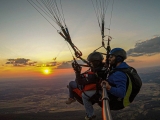To put it into perspective, snow reflects 80% of sunlight—four times more than water (20%) or sand, which reflects between 10% and 25%. At higher altitudes, this reflection increases by 10% for every additional 1,000 metres. Even on cloudy or stormy days, wearing protection is non-negotiable.

That’s why it’s crucial to invest in high-quality sunglasses without worrying about the cost. Opt for glass or organic lenses—never plastic, as it fails to block UV rays. Polarised filters are highly recommended to reduce glare. For more tips, check out this guide on how to choose snow goggles.
Modern sunglasses don’t just shield your eyes from solar radiation; they also combat wind-induced dryness. When skiing or snowboarding at high speeds, frequent squinting can lead to discomfort or even loss of control.

Additionally, airborne particles or tiny ice crystals can irritate your eyes, causing itching and discomfort.
If you wear prescription glasses or contact lenses, ensure your snow goggles are prescription-certified. Contacts exacerbate dryness, especially in winter’s cold, snowy, high-altitude conditions.
Don’t overlook children and teenagers—their eyes are up to six times more vulnerable than adults’.

Risks of Skipping Sunglasses in Snow
- Medical conditions: Photo-keratitis (sunburned eye tissue), accelerated cataracts, or macular degeneration (common in older adults)—known as "snow blindness". If symptoms occur, consult a specialist immediately. Rest in a dark room with eyes closed/covered, and avoid contacts during recovery.
- Delayed onset of severe pain hours after exposure.
- Redness, gritty sensations, and excessive tearing.
- Reduced visual acuity.
- Light sensitivity.
- Conjunctivitis.
- Corneal or conjunctival carcinoma.

Don’t cut corners—eye health isn’t worth the risk.












